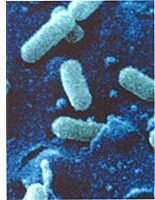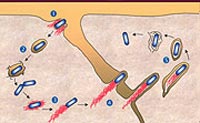
 |
| Seen through an electron microscope, listeria bacteria adhere to the intestinal mucosa. (Photo: GBF, Professor Heinz) |
How do bacteria penetrate the human organism? How do they circumvent our immune system and ultimately make us ill? And how can these tormentors be curbed effectively?
These and other questions are of interest to scientists from the German Research Centre for Biotechnology in Braunschweig and from the University of Giessen.
The focus of their research is on listeria. These bacteria are widespread: they can be found in soil, on plants, in sewage, but also in salad, vegetable, milk and sausage. They continue to proliferate even when refrigerated.
Listeria are sophisticated bacteria. They trick the cells of the intestinal mucosa into incorporating them. This is an ideal hideout, as it makes the listeria "invisible" to the body’s immune system for a while. Starting from the intestine, the pathogens travel through the body. In healthy individuals, listeria usually do not cause any medical conditions.
However, persons with a weakened immune system and newborn babies often come down with flu-like symptoms and meningitis. Frequently, this is fatal. An infection during pregnancy often leads to a miscarriage.
 |
| Listeria bacteria (blue) penetrate the intestinal cell (beige) and infest the neighboring cell. (Photo: GBF, Professor Heinz) |
Specially made stranglehold
The researchers learned that the bacteria outsmart the cells of the human intestinal mucosa using a sophisticated mechanism:
On their surface, intestinal cells carry the protein "E-cadherin". This protein is linked to the E-cadherins of neighboring intestinal cells and thus creates a protective barrier against pathogens and exogenous substances.
The listeria have developed a key tool called "internalin", which allows them to precisely identify the E-cadherin. "Internaline resembles a twisted horseshoe and locks the E-cadherin in a specially made stranglehold," Dr. Wolf-Dieter Schubert from Braunschweig explained. Thus the listeria bacterium adheres to the intestinal cell, which is forced to incorporate it.
Page 2: How an image of the stranglehold between internalin and E-cadherin was accomplished.




